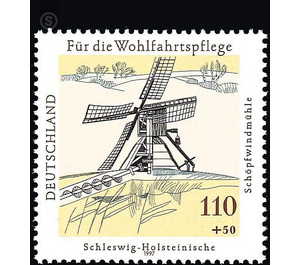welfare: Water and windmills in Germany - Germany / Federal Republic of Germany 1997 - 110 Pfennig
Theme: Architecture
| Country | Germany / Federal Republic of Germany |
| Issue Date | 1997 |
| Face Value | 110.00 |
| Color | yellow |
| Perforation | K 13 3/4 |
| Printing Type | Multicolor offset printing |
| Stamp Type | Postage stamp |
| Item Type | Stamp |
| Chronological Issue Number | 1824 |
| Chronological Chapter | GER-BRD |
| SID | 147112 |
| In 31 Wishlists | |
On October 9, 1997, the 48th Welfare Stamp Series is released in favor of the Free Welfare. The recipient of the proceeds from the sale of these special stamps is the Federal Working Group of the Free Welfare Care Association, in which the Arbeiterwohlfahrt, the Diakonische Werk of the EKD, the German Caritas Association, the German Paritätische Wohlfahrtsverband, the German Red Cross and the Central Welfare Office of the Jews in Germany have united , These organizations help wherever government aid is not enough. The motifs of this year's charity brand series are water mills and windmills in Germany. The superficial watermills in the Black Forest and in Hesse are usually more than just flour mills. The power of the water is used to drive sawmills, oil mills or hammer mills. There are often Bockwindmühlen, where the entire mill house is rotatably mounted on the block as a substructure. The Schleswig-Holstein scoop windmill makes it clear that not only grain was ground in the mill houses. It is connected to an Archimedean screw, which serves to pump out excess water, protecting the marshes from flooding. An alternative form of drive to windmills in this region is the Gallery Dutch windmill. Only their hood must be turned into the wind to ensure the energy supply. The mill body constructed with a circumferential gallery is immovable. Everyone knows them, the water and windmills, and yet their numbers are significantly reduced today. Due to industrialization and automated grinding processes become unprofitable, the mills are usually operated only in the context of an open-air museum or by one of the many German mill associations as a technical monument. While the windmills have remained largely visible as a landmark architecture after being closed down and converted, many water mills are rather inconspicuous buildings, which often lack the ability to identify the mill wheel. Already around 4000 BC. is the grating of grains between two millstones, initially in the form of stone hand mills, occupied. From the Egyptians, the Assyrians, the inhabitants of Catal Hüyük in Anatolia or other early civilizations, there are pictorial testimonies that show women moving the rubbing stones on a base plate or grinding the grain with a mortar-like construction.


